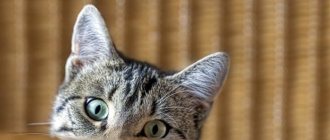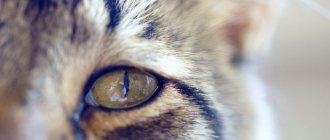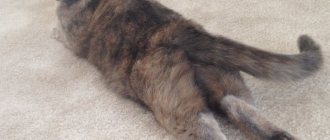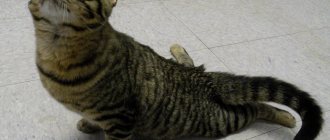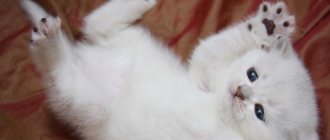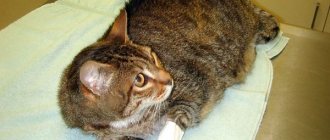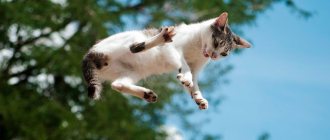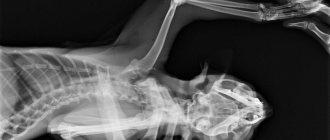Body temperature in cats is one of the main indicators of the health of a pet. Any deviations from the norm can signal various system failures, pathological processes in the animal’s body, provoked by disease.
If the animal’s condition has worsened, in order to notice the danger in time, cat owners must know how to measure their pet’s temperature, what body temperature should be normal for a cat, and what indicates health problems for their furry pet.
Why do cats have hot paw pads? If a cat has hot ears, what does it mean and what to do?
If a cat has hot ears, what does it mean and what to do?
Cats have a normal body temperature higher than humans, so sometimes your pet's ears may seem hot. To check if your pet is sick, you need to touch his nose; if it is wet and cool, then there is no need to worry. A dry and warm nose signals illness: - infection; - injuries; - inflammation; — diseases of the gastrointestinal tract; - stones in the bladder.
The pet's temperature is immediately measured; 38-39 is considered normal. Observe the behavior of the animal; if the cat has become lethargic, sleepy, and constantly lies down, then this indicates ill health. If you have any alarming symptoms, you should immediately contact your veterinarian. The pet needs to be given time, taken care of, and provided with proper care.
You can lower the temperature at home by using echinacea or astragalus tincture. The dose is calculated based on the weight of the animal, 8-10 drops of tincture per 10 kg. Give the cat a bowl of water, because at a temperature the pet will drink a lot.
If a cat has hot ears and paws, a warm dry nose, what does this mean?
A warm and dry nose combined with hot ears are signs that your pet is sick. The animal has an elevated body temperature, which is associated with diseases - infections, inflammation, gastrointestinal diseases.
If the cat's behavior is normal, without lethargy, then perhaps the pet is simply overheated. This is not scary, but it is still better to measure the temperature.
The cat has hot ears but a cold nose after childbirth, cesarean section, sterilization
After giving birth or cesarean section, cats may have a slight increase in temperature for a couple of days, this is not a cause for concern. Of course, if the ears are hot and the nose is wet and lethargic for several days, then it is possible that the pet has a very high fever and needs to immediately contact a veterinarian.
Sterilization should not cause a fever; the cat may have hot ears and a wet nose - this is normal. But if your nose is dry and hot, then you should immediately consult a doctor.
The cat has hot ears and head after castration, is a wet nose normal or not?
If a cat has been neutered, his ears may become warmer, but there should be no fever. Your pet needs supervision and care to make recovery from anesthesia easier. A wet nose and a hot head are an indicator that the cat does not have a fever.
The normal body temperature of a cat is 38-39.5°C. For a person, this temperature indicator is on the verge of critical. Therefore, touching a cat and feeling that the cat is hot
, the owners begin to panic.
Don’t be nervous right away, first measure your pet’s temperature - this is relative to your body temperature. The cat is hot
, but for him the temperature is within the normal range.
Also just a hot nose on a cat
, in the absence of any other symptoms, is by no means an indicator of ill health.
The cat has just woken up; in a few minutes the temperature balance will be restored. The animal is scared or nervous; stress is a common reason why a cat is hot.
The heat caused by these reasons, after a short time,
the cat's hot nose
will return to normal temperature.
Symptoms of fever in cats and kittens
But if the thermometer shows over 39.5°C, and the cat has hot ears and a dry nose,
There are reasons for concern, especially if you have symptoms such as:
- The cat refuses food and water; General lethargy, drowsiness; The cat's ears are hot
, red, swollen, with an unpleasant odor;
Hides from the light, from hands, behaves inappropriately; The cat's nose is hot and dry
, with dried purulent crusts;
Signs of a cold (sneezing, coughing, runny nose, eyes).
Explanation Why the Cat Is Hot
in this case, there can be one thing - there is an inflammatory process in the body.
The cat has hot ears
There are also other reasons:
- head and ear injury, infectious or viral disease;
Is it dangerous
Hot ears in themselves are not a dangerous symptom. Hairless species have naturally hot ears; this is completely normal for them. Or rather, we feel that they are hotter because they have no fur. If the ears are hot, but the cat behaves as usual: eats, sleeps, goes to the litter box, plays, then there is no need to worry.
But if the behavior changes, the cat becomes lethargic, does not eat anything, goes to bed, or vice versa - runs around, meows restlessly, while her nose is dry and her ears are hot - this is an alarming symptom. She needs to be taken to the vet.
Hot ears really tell owners when a cat's temperature rises. Normal cat ears are pale pink or white. If they turn red, it means your blood pressure has increased. The temperature must be measured with a thermometer. First, the tip is lubricated with vegetable oil or Vaseline, and then carefully inserted 1 cm into the anus, the measurement duration is 3 minutes.
If the animal is worried, shakes and twitches its head in different directions, often raises its paws, scratches its ears, it is necessary to urgently examine the ears. This is not easy to do because of pain and irritation; usually the cat is worried and does not allow his ears to be touched. If there is a brown coating, lumps of dirt, or crusts from scratching, this is an ear mite.
Experienced breeders know what to do at home. Hydrogen peroxide or vegetable oil is dripped into the ears, then the plaque is removed. Veterinarians usually prescribe Bars drops for cats. Otodectosis is an unpleasant and dangerous disease with terrible consequences: otitis media and treatment with antibiotics, in severe cases – partial and even complete loss of hearing.
Sterilization, castration, difficult childbirth have a strong impact on the mental state of pets. During this period, they are lethargic, the temperature is elevated, the ears are hot and the nose is dry. Some days they need special care.
Experts believe that a dangerous symptom when a cat is sick is cold ears. This indicates that the body is weak and exhausted. If the ears are hot, it means there is a fight against the disease, so there is every chance of overcoming the disease.
What to do if the cat or kitten is hot?!
All of the above applies to kittens, but due to the development of the body, all sores are much more severe. The baby's immunity is fragile due to hormonal changes. Therefore, if the Kitten is hot, the kitten has a hot nose
, and when measuring the temperature you see frightening numbers on the thermometer, you can’t hesitate, the baby needs to be shown to the doctor.
Excessively hot paws on a kitten
also indicate an elevated temperature.
So, you discovered that the cat has a hot
Nose,
you noted an elevated temperature -
What to do
next?
The animal should be shown to a specialist as soon as possible.
In order not to drag a sick cat to the clinic, the best option is to call a veterinarian at home. The veterinarian comes to your home with all the necessary tools and medications to provide the necessary veterinary care.
The health and well-being of a cat is evidenced by an excellent appetite and cheerful state. A hot nose in a cat often signals some kind of health problem, although not always. There are several conditions and situations when a healthy cat's nose becomes dry and warm. In order not to make a mistake and accurately determine whether everything is fine with the pet, you need to understand this issue more deeply.
Alternative version
There is a more romantic version of why a cat tramples you with its paws..
A group of researchers suggests that in this way the pet “absorbs” the negative energies of the person. Having felt the “portal”, the cat acts as a conductor of negative information. Reading it from the owner’s body, the mustachioed striped one directs its flow into space. This hypothesis can be supported by the fact that during the process of trampling, the kotofeich closes his eyes and, as if reading mantras, meditates.
Which explanation to choose is up to you. In any case, do not chase the purr when it tramples you with its paws. After all, in this way she shows her love and appreciation for you.
Authors of the articles: Belanta Clinic team
A cat has a hot nose - reasons
If you find a hot nose on your cat, do not rush to panic. Probably the reason for this was something from this list:
- The cat recently woke up
- during sleep and immediately after, her nose remains warm and dry for some time;
The cat has experienced stress or has been actively playing
- a general increase in body temperature against this background also leads to a warming of the nose;
There is dry air in the room
- this problem is especially pressing in winter, when heating radiators are running, as well as in summer, when the air temperature is very high.
If the cat has no other signs of illness or illness, the condition of its mucous membrane and the outer surface of the nose will most likely return to normal after a short time. What does it mean if a cat has a hot nose for a long period of time (2-3 hours): there is probably a pathogenic bacillus in its body. In this case, pay close attention to see if your cat has any of the following signs, and if so, it’s time to see a veterinarian:
- refusal to eat, loss of appetite, or vice versa – insatiable appetite and thirst; high body temperature (above 40°C); dyspnea; runny nose, cough; vomiting, constipation, diarrhea; change in fur color, hair loss; drowsiness, apathy, anxiety, aggressiveness.
Hot nose in a cat after giving birth
Childbirth for a cat, like for a person, is a stressful situation. On the day the contractions begin, the cat becomes restless, walks around the room a lot, periodically trying on the prepared place - the “nest”. At the same time, the rectal temperature decreases by a couple of degrees. As the pain intensifies, her pulse and breathing rate increase. It is quite expected that a cat's initially cool or warm nose will gradually become hot. After labor is over, she will need some time to recover, after which the temperature of her body, nose and ears will return to normal.
If something went wrong during the birth of the kittens, there was an infection in the uterus or you see excessive bloody discharge, most likely her nose will be dry. In this case, a hot nose in a giving birth cat will indicate a general rise in temperature due to inflammatory or other painful processes in the body. To help her, you will need to contact a specialist.
The cat has a hot nose and is sneezing
Colds do not bypass our furry friends. Dry mucous membranes are not able to trap pathogens that penetrate the nasal passages, causing a response - sneezing. When a cat has a warm nose and is sneezing and snorting, he most likely has developed a cold. Additional symptoms are decreased activity and appetite, and a general increase in body temperature. Although sometimes sneezing is a sign of a foreign body getting into the nose. Or it could be a symptom of an allergy, such as to the chemicals you use when cleaning.
The cat is lethargic, the nose is dry and hot
Cats, like people, can freeze during a walk during the cold season or simply catch a cold in a draft. If you see that the cat has a hot and dry nose, he himself has become lethargic and apathetic, his appetite has decreased, this indicates the presence of a cold, viral or infectious disease. A competent veterinarian will be able to more accurately determine the disease and prescribe treatment.
What does it mean if a cat has a hot nose and diarrhea?
The cat is shaking with small tremors and a hot nose
When a cat has a warm nose (and even hot) and this is accompanied by trembling, the following conditions may be the cause:
Often, heavy breathing in cats, as in people, is associated with inflammation of the mucous membrane inside the nose and narrowing of the nasal passages. This happens with colds. There are other cases when heavy breathing is accompanied by the fact that the cat has a hot and dry nose, what does this mean:
- the animal probably has heart problems or pleurisy; perhaps the cat is simply scared, he is stressed, accompanied by a rapid heartbeat and rapid breathing; changes in breathing may be associated with overheating or hypothermia of the cat; in the presence of infections and viruses, diseases of internal organs, difficulty breathing becomes one of the indirect signs; with various injuries, especially if the chest is damaged, the animal’s breathing causes pain, it becomes heavy and uneven.
The cat has a hot nose and paws
We have thoroughly dealt with the question of why a cat has a warm nose. However, sometimes owners notice that their pet has hot paw pads and begin to panic. If we remember that cats have the only uncovered part of their body are their paws, and that their body temperature is normally 1-2 degrees higher than that of a human, then we can assume that in most cases the fears and fears of the owners are not well founded. It’s another matter if the animal’s general body temperature is higher than normal. Take a closer look at other symptoms of illness and, if necessary, contact a veterinarian.
Why does the cat have hot ears and nose?
When a cat has a warm, wet nose in combination with hot ears and this is not associated with banal overheating or stress, one of the following diseases can be suspected:
- inflammation; infection; gastrointestinal disease;
When is there no reason to worry?
Hot paws in a cat do not always indicate a developing disease. The body temperature of an animal is higher than that of a person, so this condition does not always indicate pathology and in most cases is considered natural.
You should also not worry too much after walking in cold or hot weather. The pads quickly warm up after being outside, and this state lasts for at least an hour.
The exception is a walk in severe frost, which threatens frostbite on sensitive and unprotected skin. In this case, it is recommended to carefully examine the animal and if there are signs of hypothermia (change in skin tone, increased anxiety of the pet, the appearance of blisters or peeling), immediately go to the veterinarian.
Cats may also have hot paws from childhood. This phenomenon is considered normal; you should not use any medications to reduce the temperature. If there are no other signs of disease, the animal feels great, does not complain of appetite, and there is no need to worry.
Why does the kitten have a hot nose?
Kittens are very playful and active, they run, jump and play a lot. Because of this, it often happens that a kitten has a hot nose, and this is not at all a cause for concern. If you notice that his nose remains dry throughout the day, it’s time to start sounding the alarm. As a rule, in this case, on the second day, discharge appears from the nose - colorless or purulent. This is a sign of rhinitis - viral, allergic, bacterial or fungal. Sometimes the reason is a foreign body entering the nasal cavity or neoplasms in the sinuses and passages.
Osteochondrosis
Yes, this disease is not limited to humans. Old cats can also suffer from it to a no lesser extent, as they begin to limp severely and lose their former mobility. By the way, how can osteochondrosis, a disease of the spine, cause lameness?
In fact, there is nothing strange about this. The fact is that with this disease the spinal roots can be pinched and pinched. The innervation of the limbs is disrupted, which is why lameness occurs. Pathology manifests itself as follows:
Any limb can be affected; with severe pinching, even the size of the front paws (or hind paws, depending on your luck) is observed.
It is believed that the disease develops due to a disruption in the process of normal formation of cartilage tissue in the animal’s body. Because of this, the layers of cartilage between the vertebrae (not the discs) are simply erased, the vertebral processes begin to rub “dry,” and the animal experiences severe pain.
It is assumed that osteochondrosis in cats is a hereditary disease. Again, be more attentive to the pedigree of your intended pet before purchasing a kitten.
In the initial stages, when the manifestations of the disease are still minor, anti-inflammatory corticosteroids can be used. If progressive lameness and other signs of pinched nerves are visible to the naked eye, surgical intervention is necessary. The operation is expensive and quite risky, but, alas, it will not be possible to do without it. What other causes of lameness in cats exist?
The cat has a hot nose - what to do?
If the cat has a hot nose and paw pads, and you do not have the opportunity to show your pet to a veterinarian, you can independently provide him with all possible help. Without harm to health, you can give it to a cat for children. A kitten can be given 1/6 of the tablet, an adult cat - 1/4 or 1/2. This drug is a good immunostimulant and has anti-inflammatory and antiviral effects. If you urgently need to reduce the temperature, you need to give an injection into the withers by adding 0.2 ml of no-shpu, analgin and diphenhydramine to the spitz.
A hot nose in a cat can be a symptom not only of a cold, but also of a more serious illness, so at the first opportunity it is better to show the animal to a veterinarian for tests and clarification of the diagnosis. Remember that with a prolonged increase in temperature, the body experiences dehydration, which can lead to weakness and death.
What to do if your cat has cold paws? This question causes great confusion if you have never paid attention to the temperature of your pet’s paws. To begin with, do not panic, even if your pet’s limbs become cold, identifying the cause and preventing the consequences is quite possible. The difficulty of diagnosis lies in the lack of anamnesis; the owner can remember whether the pet ate or drank, but not everyone can answer when and since when its paws get cold.
It’s hard to say how cold a cat’s paw pads are because a pet’s body can change by almost a degree during the day. Most cats' paws remain soft and sensitive even into adulthood. Animals that live outdoors have rougher paw pads, which means their nerve endings are not as sensitive to air temperature.
Normally,
the paw pads are slightly cooler than the body, but hotter than the air
. This situation persists for most of the day, since cats sleep or doze for up to 18 hours a day. It must be said that sleep and drowsiness are different states.
When dozing, the cat rests, but remains conscious, that is, this is one of the forms of wakefulness. Sleep is a state of rest and maximum relaxation, in which metabolism slows down, muscles rest, and the immune system works very actively. Since the Immunity is able to influence the base body temperature, a slight increase in it during sleep is the norm
.
There is also the opposite option - heat and physical activity also lead to cooling of the paw pads.
.
This happens because there are glands between the cat's toes that secrete fluid. Roughly speaking, the cat sweats with its paws
, the sweat evaporates and cools the skin. In long-haired pets, such phenomena are almost unnoticeable, since the liquid remains on the fur and practically does not cool the body.
Important!
When a cat sleeps, it should have warm paws, especially the pads of its toes.
Arthritis and arthrosis
Arthrytis (arthritis) translated from Greek means “joint inflammation.” This is one of the most common pathologies that affects old cats everywhere. Arthritis that affects one joint is called monoarthritis in veterinary medicine, and disease of two or three joints is called oligoarthritis. If not one or two, but all joints of the limbs suffer, then the name of the diagnosis changes - polyarthritis. What is arthrosis? This is the name of an inflammatory-degenerative disease, which is generally characterized by the same pathological changes in the joints.
But its essence does not change. The joints do not hurt so much without movement, without load on them, but more so with load and active games. In this case, the cat becomes very weak, completely or partially refuses to eat, and the body temperature may rise. Arthritis affects not only the joints, but also the internal organs. Among the main reasons leading to the development of the disease, veterinarians identify the following factors:
Heredity, which we have already written a lot about above.
A “lying down” lifestyle, that is, pathology very often affects castrates who are prone to low activity and rapid weight gain. If a “well-fed” cat begins to constantly fall on its front paw, it should be taken to the doctor immediately.
Unbalanced diet. This is typical for pets whose owners “don’t bother” with choosing the right, complete diet.
We can also mention our ecology, which has a detrimental effect on the health of not only humans, but also their pets.
Various infections.
How to warm a cat's paws
As written above, your task is to determine the base body temperature and if it is normal, but the cat’s paws are still cold, you need to try to warm them. First, evaluate how warm it is in the home and how the pet behaves:
- Does the cat walk on the floor or prefer to move on the top? The higher you go, the warmer the air.
Perhaps your pet is freezing?
- Perhaps the cat was moulting and the weather suddenly got colder - our pets are warmed by the undercoat, not the guard hair.
- Does your pet climb into your bed to sleep? If so, she is looking for additional heat sources
.
The best option is Insulated with a thick backing
. Recently, recommendations have appeared on forums about insulating houses with heat-insulating fabric. Yes, it doesn’t look very attractive, but you can’t lure cats out of their warm nests.
Note!
During sleep, the temperature and heat transfer of a cat’s body increases, therefore (if the house is cold) the pet may freeze in its sleep.
Interesting facts about cat paws
Cat paws are associated with cleanliness, silent steps, acrobatic dexterity and clawed grip. However, in addition to this, the feet of a cat play a large role in touch and thermoregulation, namely:
- The soft, fleshy pads are covered with delicate, non-rough skin, rich in nerve endings, and are therefore very sensitive to touch and the texture of the coating. Prickly and squishy, cold and overheated surfaces create obvious discomfort for cats.
- The flesh of the pads is penetrated by an extensive network of blood vessels that change their diameter and blood supply depending on the temperature of the air, the covering and the body of the animal. Thus, through the hairless skin of the pads, heat is exchanged with the environment by convection.
- The pads of a cat's paws, unlike the rest of the body, are equipped with sweat glands, as a result of which thermoregulation is also carried out through sweating. “Sweating through the paws” prevents overheating, however, wet traces after the cat has walked across the floor remain not only in hot weather, but also under stress.
- Normally, at room temperature, a cat's paw pads feel a little colder to the touch than their tummy, but feel pleasantly warm to the human hand.
Possible ailments
Cold extremities can indicate a number of ailments that may occur slowly or even unnoticeably. To compile an anamnesis, you need to observe your pet for 3-4 days, recording changes in the temperature of the paws.
Cooling of the extremities after or after
, used for other purposes. Narcosis is a drug and the body is in a state of severe intoxication. Reduced body temperature protects the brain from the harmful effects of the chemical components of the drug. Even in the summer, after anesthesia, it is recommended to keep the cat on a heating pad until it comes to its senses and goes to a cooler place.
For many owners, cats become full-fledged members of the family. They worry when their pets feel unwell, lose their appetite, and become lethargic. Often cat owners focus on their pet's nose. In this article we will talk about what to do when a cat has a dry nose and why this happens.
Many owners are concerned with the question of what a healthy kitten’s nose should be like. First of all, a healthy nose is a moist and cool nose that glides a little. This is due to the nature of the animal. In fact, cats are predators for whom the nose is the main assistant in the hunt. The wet organ helps determine where the wind is blowing - this is necessary so that the victim does not smell the cat's scent. This is why having a wet nose is important.
When determining the health of a pet, it is necessary to take into account the type of activity of the kitten. If he has just woken up or was engaged in active play, then he may experience a dry nose. This is due to the fact that pets have a higher body temperature than their owners, and therefore moisture evaporation occurs more intensely. Physiological causes of dryness are:
- awakening; active games; hot room; sharp fear; prolonged exposure to the sun; sedentary lifestyle.
Pathological conditions
Cold paws can also indicate a number of diseases or pathological conditions. Thus, persistent coldness of the extremities is observed:
- In the postoperative period upon recovery from anesthesia. This is why veterinarians recommend keeping an unconscious cat on a heating pad even on a summer day.
- Due to external or internal bleeding, since blood loss leads to a decrease in circulating blood volume.
- When dehydrated. Severe diarrhea and vomiting can lead to disruption of the water-salt balance in the body and thickening of the blood. To stabilize the condition, urgent administration of saline solutions orally, subcutaneously or intravenously is necessary.
- In case of poisoning. Severe intoxication may be accompanied by depression of brain and cardiac activity, salivation, pale gums, and indigestion.
- For hypo- or hyperglycemia. A significant jump in blood glucose levels leads to various metabolic disorders and coma.
- For exhaustion and anemia. If your cat looks gaunt and thin, then she may have problems digesting food. Vitamin deficiencies, problems with fermentation, anemia, and helminthiasis lead to such conditions.
- For cardiovascular diseases, including congenital valvular malformations, vascular spasms, cardiomyopathy in old animals.
- In the terminal stage of infectious diseases, when the body temperature drops and the activity of all systems declines.
It is the owner's duty to note any suspicious changes in the furry pet's condition and contact a veterinarian before it is too late.
What are the signs that require contacting a veterinarian?
If the following symptoms are detected in a kitten, you should consult a veterinarian to identify the causes of your pet’s illness:
- malaise, lethargy, apathy; dry and hot nose; cold and pale nose; change in organ color (blue, yellowish, red, white).
The owner should know that a pale and cold organ in a kitten is a sign of:
- chronic illness; hypothermia; stress; low body temperature; poisoning; complete lack of appetite.
A white and warm nose is a sign of a disruption in the kitten’s circulatory system. The blue and hot organ talks about:
- heart failure; inflammation of the respiratory organs; oxygen starvation.
When a kitten has a hot and red organ, this is a sign:
- infectious disease; rhinitis; mechanical damage.
If a kitten has a hot, dry nose and warm ears, then this is not necessarily a sign of illness, because heat exchange has not yet been established in babies, and their body temperature is higher than that of an adult pet. This may be due to the work of the body and its protection from hypothermia.
Pathological conditions
Cold paws can also indicate a number of diseases or pathological conditions. Thus, persistent coldness of the extremities is observed:
- In the postoperative period upon recovery from anesthesia. This is why veterinarians recommend keeping an unconscious cat on a heating pad even on a summer day.
- Due to external or internal bleeding, since blood loss leads to a decrease in circulating blood volume.
- When dehydrated. Severe diarrhea and vomiting can lead to disruption of the water-salt balance in the body and thickening of the blood. To stabilize the condition, urgent administration of saline solutions orally, subcutaneously or intravenously is necessary.
- In case of poisoning. Severe intoxication may be accompanied by depression of brain and cardiac activity, salivation, pale gums, and indigestion.
- For hypo- or hyperglycemia. A significant jump in blood glucose levels leads to various metabolic disorders and coma.
- For exhaustion and anemia. If your cat looks gaunt and thin, then she may have problems digesting food. Vitamin deficiencies, problems with fermentation, anemia, and helminthiasis lead to such conditions.
- For cardiovascular diseases, including congenital valvular malformations, vascular spasms, cardiomyopathy in old animals.
- In the terminal stage of infectious diseases, when the body temperature drops and the activity of all systems declines.
It is the owner's duty to note any suspicious changes in the furry pet's condition and contact a veterinarian before it is too late.
What signs will help determine the onset of the disease?
In addition to the signs listed above, the kitten also exhibits other symptoms indicating the onset of the disease. These include:
- increasing or decreasing the number of trips to the toilet; diarrhea or bloody stools; vomit; increased anxiety of the animal; hair loss; increased thirst; cardiopalmus; deep breathing; nasal discharge.
If you have these symptoms, you should consult a specialist; only he can make a correct diagnosis and prescribe treatment. You should not self-medicate, as this will only worsen the situation.
Often a kitten's dry nose is an indicator of intestinal problems, namely the presence of hair in the gastrointestinal tract. This is the only indicator of this problem.
Features of thermoregulation of hairless breeds
A special group consists of hairless cat breeds that require assistance from the owner to regulate heat production. According to observations:
- Temperatures below +26°C are cool for hairless cats, and therefore they need to be dressed in comfortable clothes that cover a significant part of the body (chest, tummy and paws). Owners of hairless cats acquire a whole wardrobe for their pets, depending on the weather, wearing either a warm woolen sweater or a comfortable bodysuit made of linen knitwear.
- An indicator of a pet’s well-being is its behavior: a freezing cat will constantly shrink into a ball, meow pitifully, hide under the blanket or jump into the owner’s arms. Hypothermia is indicated not only by the pet’s cool paws and nose, but also by the entire surface of the skin.
- In winter, it is recommended to arrange a “heated bed” for sphinxes by hanging a special hammock with a reliable frame on the central heating radiator. This will allow the animal to sleep in warmth and comfort, while simultaneously occupying an advantageous “hunting” position.
- Hairless cats should never be allowed to lie on the floor in drafts or sit near an open window. Rapid hypothermia of a naked body is fraught with a decline in immunity and serious illnesses.
This is interesting: What smell cats can't stand?
What should the owner do to help the cat?
The first thing the owner needs to do if he discovers a dry nose in a cat is to observe its general condition. Maybe she had a fever. Hot ears confirm the presence of a high temperature. It would be useful to take your temperature several times a day; this should be done rectally. Readings up to 37-38 degrees are considered normal; if it rises above 38.5, then you need to contact a veterinarian. When a kitten’s temperature reaches too high, you can help him with the following manipulations:
- wet the kitten’s fur with water from time to time; place a cold pack under the neck or on the inner thigh; provide access to clean and fresh water.
Only a veterinarian can determine why the temperature has risen, and only he can give advice on the choice of antipyretic drugs.
Now you know why a cat has a dry nose. There can be many reasons for this, and they are not always signs of illness. If they coincide with a dry nose, then you should not wait for the kitten’s well-being to improve on its own and it is better not to postpone a visit to the veterinarian.
Diagnostics
Diagnosis of vestibular diseases requires a thorough history and careful examination.
To choose the direction of diagnosis, it is important to first determine whether it is a central or peripheral disorder. It is necessary to check both auditory tracts and eardrums along with an assessment of the neurological condition of the animal
Basic laboratory tests include a complete blood count, blood chemistry panel, and urinalysis. Basic testing will also include tests for feline leukemia virus, feline immunodeficiency virus, and titers for feline coronavirus, toxoplasmosis, and cryptococcus. Evaluation of elevated immunoglobulin G titers and the presence of immunoglobulin M titers may be a sign of active toxoplasmosis infection.
X-rays of the head can help detect ear diseases by identifying changes in the tympanic bulla. However, x-ray is not a specific diagnostic method and does not show the soft tissues involved in the pathological process. New imaging techniques such as computed tomography (CT) or magnetic resonance imaging (MRI) are much better at localizing lesions in the ear or brain. MRI is particularly useful in detecting soft tissue lesions.
Because MRI is expensive, it is more often used to distinguish between central (brain) and peripheral (ear) disease after basic preliminary tests have been performed.
If encephalitis is suspected, cerebrospinal fluid (CSF) is taken for analysis. One of the most common causes of encephalitis is feline infectious peritonitis (FIP). FIP occurs primarily in cats under two years of age and is a progressive disease. The brain stem and spinal cord are the first to be affected. CSF analysis will demonstrate elevated levels of protein, predominantly globulins, and a moderate number of white blood cells, predominantly neutrophils or lymphocytes. Antibody titers or PCR virus presence may be inconclusive.
Assisting a cat with different types of lesions
If an animal is injured, which results in an alarming sign - hot paws, it is better not to try to help the cat yourself. Even a bruise can result in serious pathology and irreversible processes in the body if an error is made in treatment. The only thing you can do is try to relieve the pain with a cool compress, and then immediately go to the clinic.
When an insect bites, it is recommended to carefully examine the paw pads - often a sting remains that needs to be removed. If it is too deep, it is also best to visit a veterinarian. The doctor will prescribe anti-inflammatory drugs and, if necessary, recommend taking painkillers.
The condition is no less dangerous if hot paws are caused by a burn from chemicals. Veterinarians warn that the damage can be serious and lead to severe disruptions in the functioning of the circulatory system and tissue death. Immediately rinsing the affected areas with warm water and a cool compress will help relieve pain. Do not treat the burn yourself - it is recommended to trust a specialist.
In case of an allergic reaction, changing the food is usually sufficient. Eliminating foods that cause anxiety to the animal from the diet will quickly get rid of the alarming sign. It is recommended to feed your pet dietary food for several days - this will speed up recovery.
Veterinarians warn that if a cat has hot paws and a warm nose, such a sign may indicate a serious cold. In this case, you should not wait for the symptom to go away on its own - only immediate diagnosis with subsequent treatment will help avoid deterioration in health and the development of severe pathologies.
Consequences of rising temperatures
Often, hot ears in a cat do not indicate significant health problems. After all, it is known that these animals are big fans of lying in the sun or sitting on a hot radiator.
The cat has a swollen paw and is limping: what to do?
If after such a pastime you notice dryness and sweating of the ears and nose, you should not attribute everything to a disease. However, you need to know in what situations you need to run to a specialist.
The temperature may be high as a result of the following:
- infection;
- inflammation;
- gastrointestinal diseases;
- injury;
- bladder stones;
- ear mite
Important! Stress and anxiety are often the reason why a cat has a hot head. Active play increases the heart rate, causing the temperature to rise, causing a symptom that frightens owners.
Stress
Stress suffered by a cat, even in mild form, instantly causes the release of hormones, pulse and heart rate increase, and blood pressure increases. Blood moves faster through the vessels, and the ears become hot. This phenomenon is usually short-term in nature. After the animal calms down, everything returns to normal. Sometimes stress in cats can be prolonged, which negatively affects the general condition of the animal and its nervous system.
Signs of long-term stress in cats:
- the animal often goes to the toilet, sometimes past the tray;
- the animal does not make contact with people and hides;
- the cat is not sleeping, but is intensely watching those around her;
- nervous tail twitching;
- wide open dry eyes, enlarged pupils;
- the animal often licks, scratches and yawns;
- the animal moves unusually on its paws (crawl).
Played for a long time
Long active play by an animal is an analogue of a stressful state in which hormones are activated, heart rate and blood pressure increase, and ear temperature increases. In this state, it is enough for the cat to calm down and rest for 20-30 minutes. The ear temperature returns to normal.
